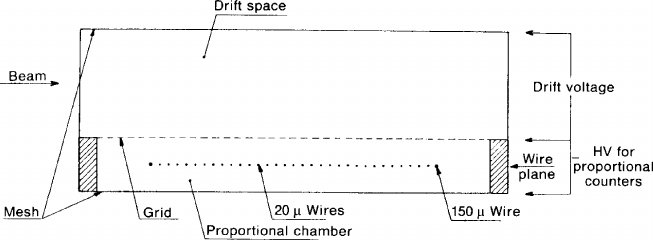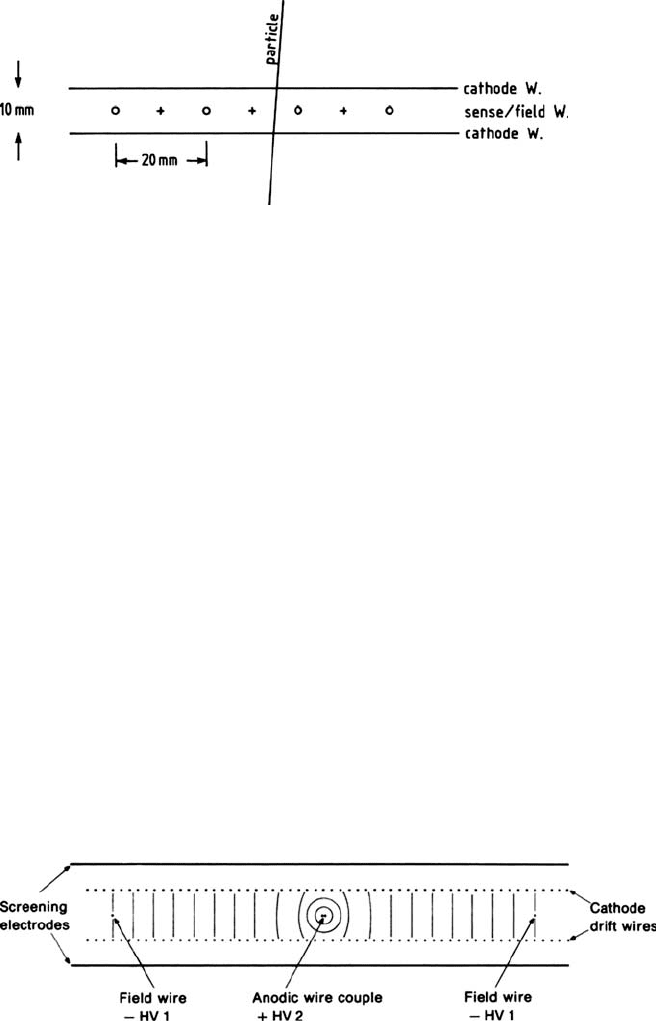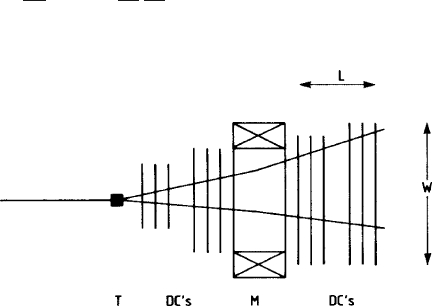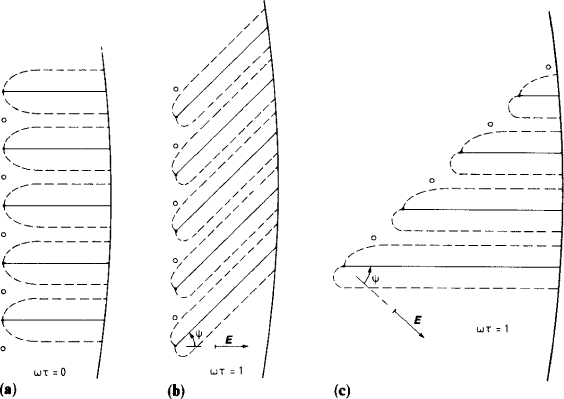Blum W., Riegler W., Rolandi L. Particle Detection with Drift Chambers
Подождите немного. Документ загружается.

362 11 Existing Drift Chambers – An Overview
are often used in stacks of several parallel chambers. The first working drift-chamber
system, which was built by Walenta, Heintze and Sch
¨
urlein [WAL 71], was of
type 1.
Types 2 and 3: The particle traverses a sensitive volume. The ionization electrons
of a number of track pieces are collected on an equal number of sense wires, and
several coordinates are measured along the track. Such an arrangement allows the
measurement of track directions and, if a magnetic field is present, of track curva-
ture. If the sampling of ionization along the track is done often enough, there is
the possibility of determining the ionization density to a degree useful for particle
identification.
One type of volume-sensitive drift chamber consists of an arrangement of a large
number of parallel or almost parallel sense wires that span the volume, usually in-
terleaved with equally parallel field-shaping wires: this we call type 2.
Chambers of type 2 may be thought of as consisting of many chambers of type 1
in the same volume. Obviously there is no sharp dividing line between types 1 and 2.
We will call a drift chamber that presents a sensitive area to the penetrating particle,
but measures the particle track with several sense wires, a ‘type 1 multisampling
chamber’, its depth in the particle direction being considerably smaller than the
linear dimensions that span the area.
A quite different type of volume-sensitive drift chamber is characterized by a
sensitive volume which is free of wires; the wires are located on one or two sur-
faces that delimit the drift region. This we call type 3. Well-known examples are
the universal track detectors that carry the name ‘time projection chambers’ (TPCs).
In their original form they have segmented cathodes (pads) behind their sensitive
wire planes, and the electric field is parallel to the magnetic field; later on, TPCs
were also built without magnetic field. Other type 3 chambers include the large drift
volumes built for particle identification where all tracks are drifted onto one cen-
tral wire plane for ionization measurement, or the spiral drift chamber where the
electrodes are situated on a cylinder mantle.
For a type 3 drift chamber, the use of the name ‘time projection chamber’ is
as vague as the name is fanciful (time cannot be projected). There seems to be
a tendency now for many constructors of new type 3 drift chambers to call their
device a ‘TPC’.
11.2 Historical Drift Chambers
Throughout this book, we are usually not concerned about the originators of each
of the many ideas which together represent our knowledge about drift chambers. In
this section we want to make an exception and follow the roots of the drift chamber
itself as well as of its two later configurations, the types 2 and 3.
The possibility of using the time of the signal for a coordinate determination
was already recognized by the authors of the paper that introduced the multiwire
proportional chamber, or ‘Charpak chamber’, as it was then called [CHA 68].

11.2 Historical Drift Chambers 363
The first studies exploiting the drift time for a coordinate measurement were
done by Bressani, Charpak, Rahm and Zupan
ˇ
ci
ˇ
c at CERN in 1969 [BRE 69]. It is
here that the word ‘drift chamber’ makes its appearance in the literature. A 3-cm-
long drift space was added to a conventional multiwire proportional chamber with
dimensions 12×12 cm
2
; it was separated from the drift region by a wire mesh with
90% transparency. The ionization electrons of a beam particle drifted orthogonally
through it onto the sense-wire plane, where they were measured on 15 proportional
wires that were spaced at 2 mm. We reproduce in Fig. 11.1 the historic picture of
this first drift chamber. Drift-velocity measurements and resolution studies were
done with it. The crucial role of diffusion for the accuracy was recognized.
The documentation of this work is not easy to find because it was published in the
proceedings of an International Seminar on Filmless Spark and Streamer Chambers
in Dubna, with contributions mainly written in Russian. The early investigations
were later reported in a wider context by Charpak et al. [CHA 70].
The first operational drift-chamber system including electronic circuitry and dig-
ital readout was built by Walenta, Heintze and Sch
¨
urlein [WAL 71]. The chamber
was organized in a novel way, consisting of a multiwire proportional chamber with
large wire spacings as shown in Fig. 11.2, where the drift-time measurement gave
the coordinate between the wires, thus improving accuracy and using fewer elec-
tronic channels compared to the MPWC. The ionization of a measured particle was
amplified on one proportional wire. This geometry, which in our classification is
of type 1, was later to be developed into a form where the drift field was extended
and made more homogeneous by introducing field wires on graded potentials. An
example is the type 1 chamber by Breskin et al. schematically shown in Fig. 11.3
[BRE 75]. Further important developments of the drift-chamber technique had been
reported by the CERN group [CHA 73].
If the creation of the drift chamber out of an array of proportional wires was
an important invention which produced many branches of useful particle detectors,
the appearance of one of its principal configurations, the type 2 drift chamber, was
part of a rapid development towards larger drift chambers and represents a much
smaller ‘quantum jump’. When the new e
+
e
−
storage rings like DORIS and SPEAR
Fig. 11.1 Disposition of the electrodes of the first drift chamber. Original drawing by Bressani
et al. [BRE 69]

364 11 Existing Drift Chambers – An Overview
Fig. 11.2 Disposition of the electrodes in the chamber built by Walenta et al.
required particle tracking in all directions around the interaction point, the most ob-
vious design was the one where several cylindrical type 1 chambers with increasing
diameters were inserted into one another, each one an entity that could be pulled
out for maintenance. The MARK I drift chambers and the PLUTO spark chambers
were examples of this geometry.
The first genuine type 2 drift chamber was that of the old MARK II detector at
SPEAR [DAV 79]. Its designers had taken the essential step of filling the entire sen-
sitive volume with wires strung between two opposite end-plates, having done away
with all intermediate ring-shaped structures and gas foils, thus paving the way for a
new generation of larger volume-sensitive drift chambers of very high accuracy. A
description of the state of the art in 1981 may be found in [WAG 81] and [FL
¨
U81].
The origin of the type 3 drift chambers is in Oxford. The ISIS project for the
Identification of Secondaries by Ionization Sampling was first described in 1973
[MUL 73, ALL 74], and a prototype with an 85-cm-long drift was tested the same
year [see ALL 82]. The basic idea was a large sensitive volume that contained only
gas and an electric field, the track ionization being collected and measured on a
single wire plane. Multihit electronics recorded the drift times of all the tracks of
one event, thus producing a direct image of the event in one projection. The purpose
of the apparatus was not primarily a precise determination of coordinates (for this
the diffusion was too large as a consequence of the long drift) but the measurement
of ionization density for particle identification. A later version of ISIS is described
in Sects. 11.7 and 10.7. ISIS can be considered a predecessor of the TPC.
Fig. 11.3 Disposition of the electrodes in the chamber built by Breskin et al. [BRE 75], cathode
wires at uniformly decreasing potentials produce a long and homogeneous drift field

11.3 Drift Chambers for Fixed-Target and Collider Experiments 365
The first time the TPC concept appeared on paper was in a laboratory report by
D. Nygren [NYG 74]. The chamber was subsequently built at Berkeley and SLAC
for the PEP-4 experiment. Again, it is not easy to find access to a documentation
of this work. A very detailed description of the PEP-4 TPC is contained in the
experiment proposal of the collaborating institutes [CLA 76]. It was presented to
the appropriate bodies for approval and later widely circulated among workers in the
field. This proposal and its numerous appendices reported on many aspects of the
feasibility of a TPC. Some of this important material has never been published.
Conscious [NYG 83] of the latest work at CERN and at Oxford, Nygren invented
the TPC by performing a synthesis into one instrument of all the known elements:
long drift, diffusion suppression through parallel E and B fields, 3-dimensional co-
ordinate measurement by pick-up electrodes for x and y, and drift-time measurement
for z. This was made possible by a novel storage of the pulse train of every electrode
over the full length of the drift time. The PEP-4-TPC is described in more detail in
Sect. 11.7.
11.3 Drift Chambers for Fixed-Target
and Collider Experiments
A typical fixed-target experiment would have an arrangement of type 1 chambers
that record (together with other detectors) the reaction products behind a target. If
in addition to their directions one also measures the momenta of these particles with
the help of a magnet, then we have a magnetic spectrometer, a typical form of which
is schematically drawn in Fig. 11.4. Stacks of planar type 1 chambers have been in
wide use for such spectrometers.
As for the momentum-measuring accuracy
δ
p/p at a given bending power p
B
of
the magnet, the contribution of each arm is, in a first approximation, proportional to
δ
x/L, the ratio of the chamber point-measuring accuracy to the length of the lever
arm (or thickness of the stack):
δ
p
p
= const
p
p
B
δ
x
L
.
Fig. 11.4 A typical magnet
spectrometer behind a fixed
target T, using stacks of type
1 drift chambers (DCs) in
front of and behind the
magnet M
366 11 Existing Drift Chambers – An Overview
Often there is freedom to increase L; then the value of
δ
x is less critical, but the
dimensions W of the chambers must be increased in proportion.
For the study of very-high-multiplicity events in heavy-ion fixed-target experi-
ments, even type 3 chambers have become popular. The direct three-dimensional
measurement of track elements is an advantage for such events (see Sect. 11.7).
An important group of drift chambers has been built around the interaction re-
gions of particle colliders where they are – together with the installed calorimeters –
the principal instruments for the investigation of the particles from the collisions.
Close to the interaction point we find the vertex detectors around the beam pipe
whose purpose it is to determine the interaction vertex with high precision. Fur-
ther out in radius the main drift chambers measure the direction and momenta of the
charged particles and, in many cases, their ionization. In the design of these tracking
devices the choice of the magnetic field and its orientation is a primary concern.
11.3.1 General Considerations Concerning the Directions of Wires
and Magnetic Fields
For symmetric electron–positron machines where one studies point-like interac-
tion – these cause essentially isotropic particle distributions – the magnetic field
B was most naturally created by a solenoid on axis with the particle beams. A good
measurement of particle momenta requires the curvature of tracks to be determined
with the greatest accuracy in the azimuthal direction. In drift chambers of type 2
it is the drift-time measurement that provides the accuracy; hence the wires are es-
sentially parallel to the magnetic field (‘axial wire chambers’). In drift chambers of
type 3 the azimuthal accuracy is provided by cathode pick-up electrodes so that the
electric drift field can be made parallel to B. Therefore, in e
+
e
−
machines we find
axial wire chambers and TPC’s along the direction of the beams. Along B, particle
curvature is not measurable.
For the study of hadron interactions in the
¯
pp and pp colliders, the magnetic field
B has sometimes been chosen to be at right angles to the beam direction, on account
of the important flux of high-momentum particles in the direction of the beams – the
UAI-experiment at the CERN
¯
pp collider and the Split Field Magnet at the CERN
Intersecting Storage Rings being well-known examples. The orientation of the wires
of type 1 or type 2 drift chambers again has to be parallel to B, which is also the
flight direction of the particles with vanishing curvature.
At the e
−
p collider HERA at DESY there is an inherent asymmetry in the en-
ergies of the colliding particles, because 30 GeV electrons collide with 800 GeV
protons. The solution adopted for each of the two experiments is a solenoid, coaxial
with the beams, instrumented with a coaxial type 2 chamber, and complemented in
the forward direction of high momenta with several planar type 1 stacks for particles
with polar angles
θ
approximately between 10 and 30
◦
. In these type 1 chambers
we find the sense wires orthogonal to the magnetic field, thus giving an accurate
measurement of
θ
and a good double track resolution in this angular range.

11.3 Drift Chambers for Fixed-Target and Collider Experiments 367
11.3.2 The Dilemma of the Lorentz Angle
In drift chambers of type 2, for an accurate determination of the curvature of an
ionization track one compares the times of arrival of the electrons from different
track segments on different wires (Fig. 11.5a-ca). The best accuracy is obtained
when the electron drift is at right angles to the track; for then the time differences
measure the curvature directly, and also the electrons of every track segment that
go to the same sense wire are most concentrated in arrival times and hence give the
smallest variance in the measurement (cf. Sect. 7.3).
However, the magnetic field B orthogonal to the electric drift field E forces the
electrons towards the direction given by the vector product – [E × B]. The Lorentz
angle
ψ
between the drift direction u and E, in the approximation of Sects. 2.1
and 2.2 (2.1.1) is given by
tan
ψ
=
ωτ
.
Figure 11.5a-cb shows the resulting disadvantage: not only does one have to
measure the sagitta under an angle of projection, but also inside every track segment
the arrival times are spread out more than before. This gives rise to the ‘angular
wire term’ in (7.26), with
α
=
ψ
, even if the track is perfectly radial. Therefore,
in this geometry one is obliged to keep
ωτ
small, although – in the interest of a
good momentum measurement – one wants the largest possible B field. This is the
dilemma of the Lorentz angle.
Since
τ
is related to the electron mobility
μ
by the approximate relation
μ
=(e/m)
τ
(for more details see Chap. 2), one way out of the dilemma is to choose a
Fig. 11.5a-c Drift paths of ionization electrons from the particle track to the sense wires. (a)
ωτ
= 0 (no magnetic field); (b)
ωτ
= 1, sense wire plane parallel to the tack; (c)
ωτ
= 1, sense-
wire plane inclined
368 11 Existing Drift Chambers – An Overview
gas with a low mobility (small drift velocity at high E field) and/or a high gas density
N to which
τ
is inversely proportional by the relation
τ
= 1/N
σ
c; cf. Sects. 2.2
and 12.5.
Another way out, but only of part of the dilemma, is a rearrangement of the wires
according to Fig. 11.5a-cc: the plane of the sense wires is made inclined to the radial
direction by the Lorentz angle
ψ
. This solution has sometimes been adopted for high
magnetic fields. Although this solution brings the drift direction back to the normal
to the stiff radial tracks, the angular wire effect in (7.26) does not vanish for them.
The importance of this effect depends on the radial sense-wire spacing.
11.3.3 Left–Right Ambiguity
The relation between drift time and space coordinate is not always unique. If ion-
ization electrons can reach a proportional wire from two opposite sides, then there
are two space coordinates to correspond to a measured signal time, one of them cor-
rect, the other a ‘ghost’. The situation arises in drift chambers of types 1 and 2, but
usually not in the type 3 chambers. (An exception is treated in Sect. 11.7.5). This
left–right ambiguity can sometimes be resolved with pattern-recognition methods
which take into account that a track produces correct coordinates that are continu-
ous and extrapolate to realistic points of origins whereas the ghost coordinates do
not make sense – provided the wires are arranged accordingly. Another possibility
is the ‘staggering’ of the sense wires, i.e. alternate sense wires are slightly displaced
from their original positions in opposite directions; the correct coordinates are the
ones that combine to form a continuous track. Still another method makes use of
the development of avalanches, which do not go around the whole wire when small
(Sect. 4.3). Suitable pick-up electrodes can identify the side of approach of the drift-
ing electrons [WAL 78, BRE 78].
11.4 Planar Drift Chambers of Type 1
11.4.1 Coordinate Measurement in the Wire Direction
Whereas the principle coordinate measurement in the wire chambers is through the
drift time and therefore orthogonal to the wire direction, for a coordinate measure-
ment along the wire other methods are needed. As we discussed in Sect. 7.1, there
are three such methods: ‘charge division’ and ‘time difference’, based on a pulse
measurement at the two wire ends, and ‘cathode strips’, based on a measurement of
pulses in sections of the cathode.
With these methods it is possible to record the positions of every track segment
(the ionization electrons collected on the wire) in all three dimensions, the position
of the wire and the drift time giving the additional two. For a true three-dimensional
11.4 Planar Drift Chambers of Type 1 369
measurement of track segments with cathode strips these must be short so that every
cathode pulse can be associated from the beginning with its proper wire signal. With
long cathode strips it is only after track reconstruction that this association can be
made. The use of cathode strips in drift chambers has so far been limited to type
1 and type 3 chambers, and short strips (‘pads’) are so far only found in type 3
chambers.
Many spectrometers were built in which a particle had to successively traverse
several parallel drift chambers, which measured only one drift coordinate for the
track; but by arranging the sense wires in different directions, the track was mea-
sured in different stereo directions, thus allowing the full track reconstruction in
three dimensions to be made. For example, a group of 9 parallel chambers could
have chambers 1, 4 and 7 with vertical wires (angle of inclination
α
= 0), chambers
2, 5 and 8 with wires inclined by
α
= 45
◦
, and chambers 3, 6 and 9 with wires at
α
= −45
◦
.
Different from a true coordinate measurement along the wires, this stereo mea-
surement of tracks does not immediately yield three-dimensional coordinate infor-
mation for every track segment. In the pattern of the drift times one would first find
the tracks in the projection of the first group of chambers, then in the second, and so
on; later, the various projected tracks would be combined in space.
11.4.2 Five Representative Chambers
In Table 11.1 we have listed five chambers of type 1 that are or were part of impor-
tant experiments in high-energy physics. In the first two chambers, particle tracks
are sampled once, whereas the last three belong to the multisampling kind.
The CDHS chambers were located between iron plates that were at the same
time the target and the calorimeter plates of this neutrino experiment, so they had to
be large and thin but were not particularly accurate. A relatively simple field-wire
configuration was found to produce a sufficiently uniform drift field if the argon-
isobutane gas mixture was used near saturation. A drift cell and its equipotential
lines are shown in Fig. 11.6. Three identical units (‘modules’) of these hexagonally
shaped chambers, with wire orientations at 0, +60 and −60
◦
, were stacked between
the iron plates.
The muon identifiers of the DELPHI experiment are the first example of a drift
chamber that has the wire amplification in the limited streamer mode. Shielded be-
hind iron as they are, the increased dead time that is caused by the streamer regime
was easily tolerable. The large pulses made it possible to use a slow delay line
(0.6 μs/m) for a coordinate determination along the wire. Measuring the time differ-
ence the authors obtained an accuracy of better than 10
−3
of the length. The delay
line is incorporated in the cathode, as depicted in Fig. 11.7. The drift field is defined
by copper strips in the plastic material of the body.
Of the drift chambers of the HELIOS experiment we discuss the small ones
immediately behind the target. Their critical requirements were accuracy and

370 11 Existing Drift Chambers – An Overview
Table 11.1 Some planar drift chambers of type 1
Name of experiment CDHS DELPHI NA34/HELiOS L3 H1
Name of chamber DC Muon Identifier DC 1 Middle Muon Chamber FTD (radial wires)
Amplification mode Proportional Limited-streamer Proportional Proportional Proportional
Method of z-measurement Stereo (successive Time difference Stereo (successive Special chamber Charge division
modules) (delay line) modules) (along r)
Reference [MAR 77] [DAU 86] [BET 86] [ADE 90] [BEC 89]
[FAB 90] [GRA 89]
Geometry
Width (cm) × length
(cm) (one chamber)
400 × 400
(hexagonal)
20 × 435 24 (diam) 163 × 556 30 (inner diam)
152 (outer diam)
Total area of these chambers in
experiment (m
2
)
720 600 0.4 280 5
No. of sense wires per cell 1 1 8 24 12
No. of cells per chamber 130 1 8 16 48
Sense-wire spacing (mm)
along the track
––6(2)9 10
Sense-wire diameter (μm) 40 100 20 30 50
Max. drift length (cm) 3 10 1.5 5 1–5 (proportional
to r)
Gap (mm) 30 20 48 360 120

11.4 Planar Drift Chambers of Type 1 371
Table 11.1 (continued)
Gas and fields
Gas (percentage
concentration)
Ar(70) Ar(14)+ CO
2
(70) CO
2
(90) Ar(62) Xe(30)
+ i-C
4
H
10
(30) + i-C
4
H
10
(14) + C
2
H
6
(10) + C
2
H
6
(38) + C
2
H
6
(40)
+ iso-propyl-alcohol (2) + He(30)
Electric drift field (kV/cm) ≥ 1 0.7 1.2 1.1 1.2
Magnetic field (T) 0 0 0 0.51 1.2
Drift velocity (cm/μs) 5.0 0.75 1.0 4.9 3
Performance (1)
Point-measuring accuracy per wire
In drift direction
σ
x
(mm) < 0.7 (c) 1 (b) 0.12 (c) 0.17 (c) (3) 0.11–0.15 (b)
0.06 (b)
In wire direction
σ
z
(mm) – 3 (b) – – 20 (b)
Double track resolution
Δ
(mm) 30 (a) 10 0.6 (b) Not known Approx. 1.5 (b)1.0 (c)
1. The performance figures are based on (a) calculation and laboratory tests; (b) prototype and test-beam measurements; (c) measurements in the running
experiment.
2. Charge collection per sense wire: 2.5–3 mm in track direction.
3. This led to a momentum resolution measured in the experiment equal to
δ
p
t
/p
2
t
= 5.3 ×10
−4
(GeV/c)
−1
for high momentum muons.
